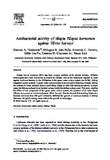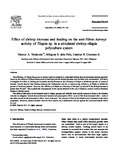Antibacterial activity of tilapia Tilapia hornorum against Vibrio harveyi
- Global styles
- MLA
- Vancouver
- Elsevier - Harvard
- APA
- Help

View/Open
Date
2004Author
Page views
6,327ASFA keyword
AGROVOC keyword
Taxonomic term
Metadata
Show full item recordCited times in Scopus
- Citations
- CrossRef - Citation Indexes: 25
- Policy Citation - Policy Citations: 1
- Scopus - Citation Indexes: 50
- Captures
- Mendeley - Readers: 96
- Social Media
- Facebook - Shares, Likes & Comments: 1
Share
Abstract
Disease due to luminous Vibrio has been a major problem of the shrimp industry. Different technologies have been introduced to control the disease. One of the techniques reported to work against luminous bacteria in the Philippines is the green water culture system (or finfish–shrimp integrated culture system). A green water culture system is an innovative technique wherein shrimp are cultured in water collected from a pond where tilapia or other fish species are grown. In some cases, the fish are cultured in an isolated net pen inside the shrimp culture pond. This study clarifies the effect of one component of the green water culture system, the presence of all male tilapia (Tilapia hornorum) on luminous bacteria Vibrio harveyi. Results showed that stocking tilapia at a biomass not lower than 300 g/m3 efficiently inhibited the growth of luminous bacteria in shrimp (biomass=80 g/m3) rearing water without the growth of microalgae.
Suggested Citation
Tendencia, E., dela Peña, M. R., Fermin, A. C., Lio-Po, G., Choresca, C. H., Jr., & Inui, Y. (2004). Antibacterial activity of tilapia Tilapia hornorum against Vibrio harveyi. Aquaculture , 232(1-4), 145-152. https://doi.org/10.1016/S0044-8486(03)00531-3
Type
ArticleISSN
0044-8486Collections
- Journal Articles [1249]
Related items
Showing items related by title, author, creator and subject.
-
Vibrio load and percentage composition of sucrose‐fermenting vibrios in Nile tilapia (Oreochromis niloticus) cultured in brackish water earthen ponds and biocontrol potential of recycled tilapia‐conditioned greenwater against population growth of V. parahaemolyticus and non‐sucrose‐fermenting vibrios in the grow‐out culture of white leg shrimp (Litopenaeus vannamei)
Pakingking, Rolando V., Jr. ; Palma, Peter
; Palma, Peter  ; de Jesus-Ayson, Evelyn Grace T.; Usero, Roselyn
; de Jesus-Ayson, Evelyn Grace T.; Usero, Roselyn  (Wiley, 2022-10-20)
Vibrio are known opportunistic pathogens of pond-cultured fish and shrimp. This study determined the presumptive Vibrio count (PVC) and percentage composition of “beneficial” sucrose-fermenting vibrios (SFVs) ...
(Wiley, 2022-10-20)
Vibrio are known opportunistic pathogens of pond-cultured fish and shrimp. This study determined the presumptive Vibrio count (PVC) and percentage composition of “beneficial” sucrose-fermenting vibrios (SFVs) ... -
Effect of shrimp biomass and feeding on the anti-Vibrio harveyi activity of Tilapia sp. in a simulated shrimp–tilapia polyculture system
The efficiency of Tilapia hornorum to control luminous bacteria in a simulated shrimp farm environment has been reported. However, the effects of different factors such as feed input and the shrimp biomass were not taken ...
-
Tilapia Farming: Proceedings of the First National Symposium and Workshop on Tilapia Farming, PCARRD, Los Baños, Laguna, November 24-26, 1986
Guerrero III, Rafael D.; de Guzman, Dalisay L.; Lantican, Cecilia M. (Philippine Council for Agriculture, Forestry and Natural Resources Research and Development, 1987)






